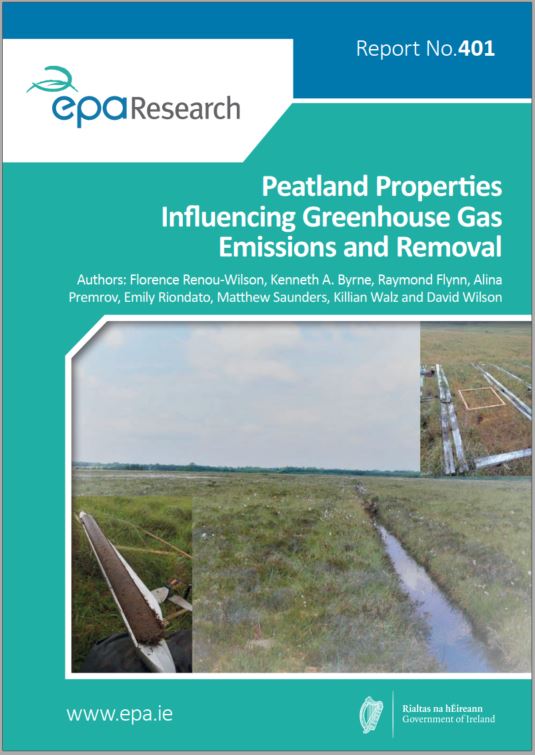Research 401: Peatland Properties Influencing Greenhouse Gas Emissions and Removal
Authors: Florence Renou-Wilson, Kenneth A. Byrne, Raymond Flynn, Alina Premrov, Emily Riondato, Matthew Saunders, Killian Walz and David Wilson
Summary: Irish bogs have been drastically altered by human activities and the sampled peat properties reflect the nature and magnitude of the impact of land use and management. A recognition of the heterogeneity found across Irish peat soils, together with an understanding of the relationships between key soil properties, are critical for developing effective strategies to reduce the carbon footprint of these degraded ecosystems. Our findings clearly support the need for a site-by-site approach for rewetting management schemes.

Project Highlights
Watch the project highlights video
Identifying Pressures
At EU level, peatlands have been highlighted to play a central role in achieving the temperature goals agreed in the Paris Agreement, and peatlands are already included in the 2030 Climate and Energy Framework [Regulation (EU) 2018/841]. Covering c.20% of the land surface, much of the peatland area has been extensively modified by humans; many peat soils are under a range of land use categories (LUCs), namely grassland, forestry or peat extraction (both industrial and domestic). When the residual peat depths under the LUCs are compared with natural bogs, a picture emerges of more intensive use of raised and mountain bogs than lowland blanket bogs. All land with peat soils is crucial in the global carbon balance, as it contains soils with high carbon content. Whether peatlands continue to store or release carbon is strongly dependent on management and site-specific properties. Action to improve the management of peatlands requires a capability to accurately report greenhouse gas (GHG) emissions/removals.
Informing Policy
Peatlands have played an important role in climate regulation over the past 10,000 years. Natural peatlands are a small carbon sink (absorbing carbon dioxide while emitting methane), but 82% of Irish peatlands have been damaged to various extents. Disturbance from human activities, mainly in the form of drainage (for agriculture and forestry) and peat extraction produce increased carbon dioxide and nitrous oxide emissions, and reduced methane emissions. To mitigate emissions from peatlands two actions must be taken: (1) avoid new or recurrent drainage and (2) reduce emissions on the existing drained areas. The rewetted and restored cutover bogs monitored in this study are carbon sinks, while their drained counterparts are substantial carbon sources. Cutover bogs hold large carbon stocks that must be sustainably managed if Ireland wishes to meet its climate change targets.
Developing Solutions
Predicting GHG emissions from peatlands requires a fundamental understanding of the role of peatland properties in the carbon cycle. Basic information on the peatland resource and associated properties has permitted a new evaluation of the carbon stock held in Irish bogs and has informed immediate management interventions to prevent further carbon losses from this huge store. Given the heterogeneity of peatlands and the current GHG status across peatland LUCs, more sites must be monitored for GHG dynamics across a wider geographical range.
Although process-based models typically require more site parameter inputs than empirical models, they are more reliable for predicting the variability in GHG dynamics under future environmental and anthropogenic changes. By applying a drainage factor, we successfully improved the water table simulation approach in the ECOSSE model and thus the ability to predict carbon dioxide emissions from drained peat soils; however, further research to improve the water component in the ECOSSE model, together with continuous data collection (particularly water table levels), especially from rewetted sites, are critical to support sustainable peatland management schemes.